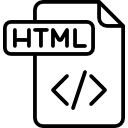HTML

HyperText Markup Language, commonly referred to as HTML, is the standard markup language used to create web pages. Along with CSS, and JavaScript, HTML is a cornerstone technology used to create web pages, as well as to create user interfaces for mobile and web applications. Web browsers can read HTML files and render them into visible or audible web pages.
HTML describes the structure of a website semantically along with cues for presentation, making it a markup language, rather than a programming language.[2]
Introduction[edit]
Content gratefully used with permission : [3]
HTML Forms[edit]
HTML Forms are one of the main points of interaction between a user and a web site or application. They allow users to send data to the web site. Most of the time that data is sent to the web server, but the web page can also intercept it to use it on its own.
An HTML Form is made of one or more widgets. Those widgets can be text fields (single line or multiline), select boxes, buttons, checkboxes, or radio buttons. Most of the time those widgets are paired with a label that describes their purpose — properly implemented labels are able to clearly instruct both sighted and blind users on what to enter into a form input.
The main difference between a HTML form and a regular HTML document is that most of the time, the data collected by the form is sent to a web server. In that case, you need to set up a web server to receive and process the data. How to set up such a server is beyond the scope of this article, but if you want to know more, see Sending form data later in the module.[4]
Click here the Mozilla documentation page with links to each input type
Helpful resources[edit]
- Good site for choosing HTML colors
- Excellent reference for HTML
- Specification for HTML 5
- Official HTML documentation
- A list of HTML elements